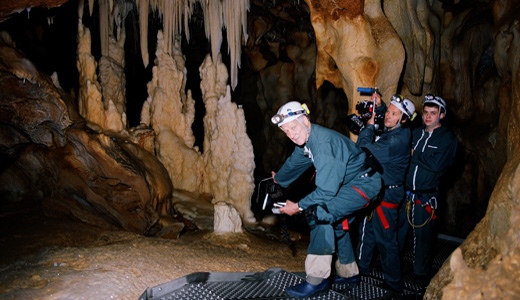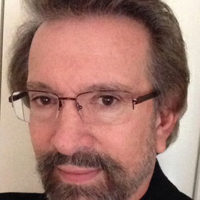
Movie Review
Cave of Forgotten Dreams
Written, directed and narrated by Werner Herzog
Cinematography by Peter Zeitlinger
90 minutes, G, 2010, U.S. release April 29, 2011
You are in a movie theatre, cave-like and dim except for the projection of light from the entrance, casting color shadows on a flat screen. You are wearing a pair of 3-D glasses. Every once in a while your eye catches some movement in front of you or off to the side. They are hands reaching out to touch the rock, feel the surface, get some Paleolithic charcoal on their fingers.
You are viewing 68-year-old German filmmaker Werner Herzog’s latest feature film, Cave of Forgotten Dreams. It’s an exclusive visit to see the paintings deep inside the Chauvet caves of southern France, arranged by permission of the French government. Very few people will ever see these paintings with their own eyes. Other prehistoric caves opened to the public have suffered contamination by human breath, so this one will be accessible only to specialists and then only rarely.
Knowledge of the cave is increasing day by day, as Herzog shows in interviews with members of the scientific community. But it’s impossible to say how many artists participated in this project, and over what length of time, to what extent humans and animals cohabited in the cave, whether indeed one can say that the creators even thought what they were doing was “art” as we know it. Perhaps success in the hunt magically depended on these very faithful and to modern eyes avant-garde renderings. Well, we do know that repetitive palm prints came from the same man’s hand, a six-footer with an observably bent pinky finger.
Herzog’s team of filmmakers and scientists are actually a little vague as to what materials the artists (for lack of a better word) used, but it seems that they entered the cave with torches to light the way, and used charcoal sticks to design and shade and sculpt horses, lions, bison, rhinoceroses, antelopes, and other animals, and only one human image, a woman’s body with a bison’s head. Many times the artists use what we consider 20th-century techniques. Remember Marcel Duchamp’s “Nude Descending a Staircase?” Now think of running mammals with eight or more legs, dueling rhinoceroses with multiple horns indicating quick movement. This stunning, shockingly “advanced” work predates Eadweard J. Muybridge’s photographic studies of animal and human locomotion by at least a few decades!
It is profoundly daunting to the modern mind to contemplate the sophisticated development of the human brain some 30-40,000 years ago. People were engaging in symbolic thinking even then, with sexualized imagery and the merging of human and animal forms. These Homo Sapiens were clearly differentiated from Neanderthals who still existed during this period, but who lacked sufficient pre-frontal cortex to engage in higher-order thought. The conscious placement of a bull’s skull on a promontory inside the cave suggests a kind of altar or a possible spiritual frame of reference.
Herzog shows the cave in eerie tones, due to limited lighting, almost as if we are being made privy to art work created by aliens from another planet. But these long-dead cave artists were quite possibly walking around and taking care of biz with the same mass of gray matter as us.
Townspeople in the area of the cave acted out their notions of how the ancient peoples utilized their weapons and musical instruments, including a bizarre rendition of “The Star Spangled Banner” (why not the “Marseillaise”?) played on a 30,000 year-old flute. Here a word about the magnificent score to this film, by composer Ernst Reijseger, who gives us spacey, New Age harmonies recalling contemporary music for the church. In these passageways lined by calcite stalagmites and stalactites, we are in a sense walking through a cathedral of nature, most of which came about only in the 20,000 or so years after the cave closed up. 3-D technology places us within palpable reach of this astounding architecture.
The Paleolithic hunter-gatherer culture would still be with us for quite a few more millennia, changing imperceptibly by adaptation to climate change. Could humans in that era contemplate a future beyond the cycle of seasons or the reappearance of certain celestial configurations? Could they plan for a better day, or accumulate enough to leave a legacy? Perhaps not. But clearly the notion of mentorship comes into play. An adult at some point had to say to a young person, “Hey, that stick figure of a bison you drew in the ground? Try modeling the head and torso a bit, give some movement to the legs, show it breathing heavily,” and an artist is born.
Herzog refers to ‘forgotten dreams.” Surely these paintings, only discovered in 1994, had been truly unknown. Yet the dreams of our ancestors, these earliest known works of art-are they so different from our own? A dream of coexisting in harmony with nature. A dream of surviving the harsh elements with adequate shelter and clothing. A dream of children and community to share life’s burden. A dream of stirring up the old campfire for a fine meal of bison. And even a dream of standing back from your work, whether killing your prey, fashioning some cozy fur boots, or painting these remarkable images, and thinking, “Damn, that’s good!”
Photo: In this film publicity photo, documentary filmmaker Werner Herzog is shown during the filming of “Cave of Forgotten Dreams.”(Marc Valesella IFC Films/AP)
Also see Dan Margolis’ Trapped in history: “Cave of Forgotten Dreams”











